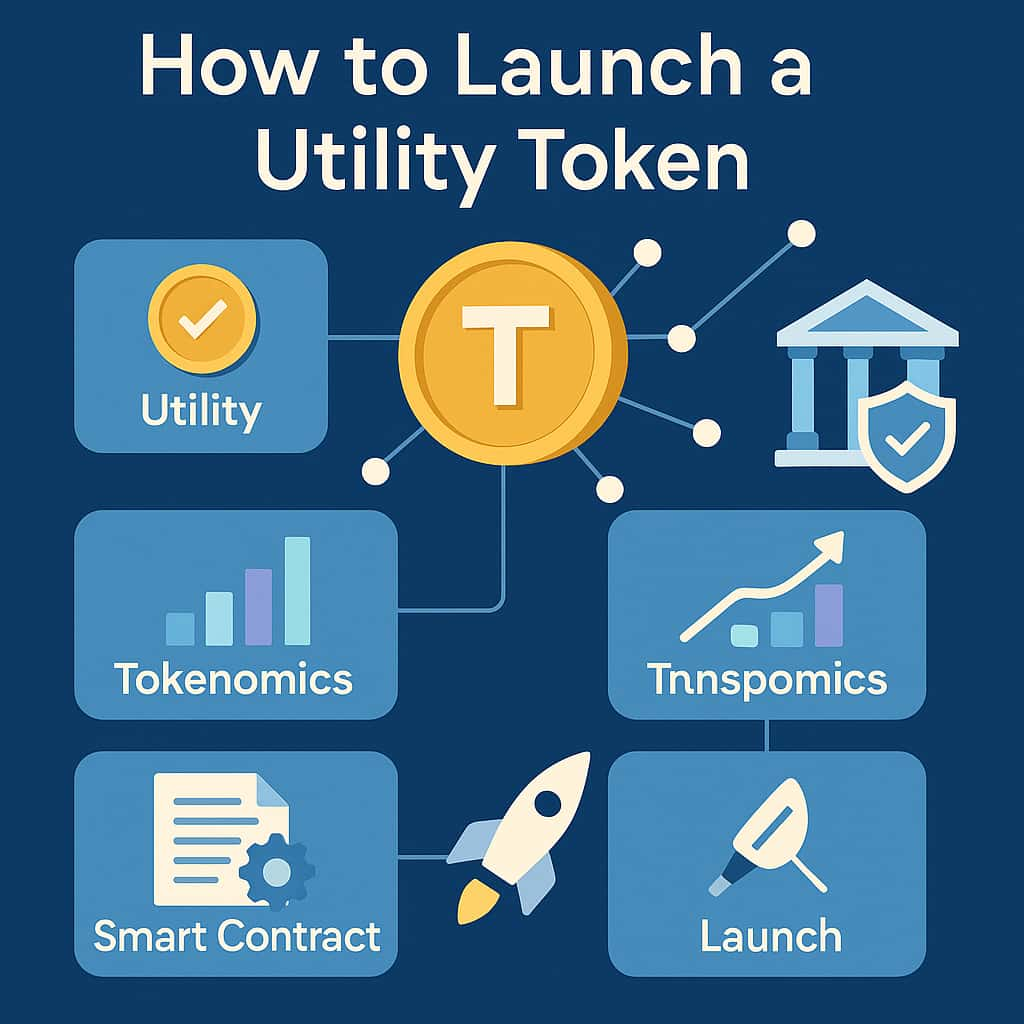-
Launching a utility token is not difficult. Launching it correctly is where most founders struggle.
A token built without clear utility, thoughtful tokenomics, and a responsible launch strategy can collapse in days, sometimes even hours. But when the token is tied to real usage in your product, supported by a strong incentive design, and launched with transparency, it becomes a long-term value engine that supports ecosystem growth, adoption, and sustainability.
This guide is written specifically for startup founders who are:
- Working toward their MVP or early product validation
- Planning to introduce a token to enable participation, governance, or marketplace mechanics
- Looking for clarity, not hype, jargon, or superficial crypto commentary
You'll walk away knowing:
- Whether your product is ready for a token
- How to design tokenomics that support adoption, not speculation
- How to structure the smart contract and vesting logic
- How to launch with legal confidence and controlled liquidity
Let's break this down with the clarity founders need
At Oodles Blockchain, a Utility Token Development Company, we help founders design and launch compliant utility tokens that scale with their products and attract real users, not just short-term hype.
Before You Launch, Confirm Your Product Actually Needs a Token
Not every Web3 startup needs a token on Day 1, and rushing token release is one of the biggest causes of ecosystem failure.
Use this Utility Test to decide readiness:
- Does the token unlock or enable a feature inside your product?
- Does holding the token provide ongoing access, status, or benefits?
- Would your product still function in a meaningful way without the token?
If the answer to #3 is yes, your token has a purpose.
If the answer to #3 is no, the token is unnecessary, at least for now.When a Token Strengthens a Product
Tokens make sense when they:
- Unlock feature tiers or subscription levels
- Represent in-app currency for a marketplace ecosystem
- Enable on-chain voting or community governance
- Incentivize meaningful contributions (staking, referrals, participation)
When Not to Launch Yet
- The only reason to introduce the token is “because investors expect it”
- The token is primarily being positioned as something that will increase in value
- Product usage is not stable enough to drive real demand for the token
If your token's main promise is price movement, not platform utility, pause and refine.
You may also Like | The Comprehensive Guide to Token Development.
What Makes a Token a Real "Utility Token"
A token is considered a utility token when it is essential to performing an action or unlocking a benefit within the platform.
It risks being treated as a security when it is primarily sold as a profit-driven investment.
Plain Rule of Thumb
- Utility Token: Users need it to participate, transact, or unlock functionality
- Security Token: Purchased to make profit from holding the token itself
Stay on the Safe Side (No Legal Overcomplication)
- Do not market your token using investment language
- Make the token's in-app function clear and necessary
- Provide simple documentation explaining why the token exists
Who Issues the Token
Most strong tokenized projects use a two-entity structure:
- Operating Company: Builds the application, earns revenue
- Foundation or DAO Entity: Oversees token governance and issuance
This separation helps with compliance, clarity, and long-term trust.
Step-by-Step Utility Token Launch Roadmap
This roadmap is designed to help founders avoid wasted time, confusion, and misaligned token models.
1) Define the Token's Role in the Product
Ask these questions early:
- What behavior should the token encourage?
- How does token ownership improve the user experience?
- Why would users hold instead of selling immediately?
The answer becomes your core utility narrative.
Practical Utility Examples
- Access Control: Stake token to unlock premium features or tools
- Marketplace Currency: Buy, sell, or rent digital goods
- Contribution Rewards: Earn tokens through action, not speculation
- Governance: Vote on ecosystem decisions (roadmap, fees, policies)
2) Design Tokenomics That Support Long-Term Value
Poor tokenomics are the most common reason tokens fail after launch. A solid tokenomics design ensures that your token is not just a speculative asset, but a sustainable component of your ecosystem.
What Good Tokenomics Looks Like
A healthy token economy depends on:
- Balanced allocation that rewards contributors, investors, and the community.
- Fair distribution so no single party holds outsized control.
- Predictable unlock schedules to prevent sudden price shocks.
- Rewards tied to real platform usage instead of pure speculation.
Key Allocation Guidelines
Team & Advisors (10–20%), Reserved for those building and guiding the project. Use a 12-month cliff followed by 24–36 months of vesting to ensure long-term alignment and discourage early sell-offs.
Strategic Investors (10–25%) - Early backers who provide not only capital but strategic value. Vest their tokens linearly over 6–18 months to avoid immediate dumping.
Public Sale (10–20%) - This allocation ensures a wide community base and liquidity. A phased or short vesting period keeps circulation active while avoiding market saturation.
Ecosystem Rewards (20–40%) - Incentivize user participation, staking, referrals, or ecosystem partnerships. Tokens should be released dynamically based on actual growth metrics or user activity.
Treasury (10–20%) - Held for future initiatives, governance decisions, and long-term ecosystem development. These tokens are often locked and managed via governance mechanisms.
Design Principles That Keep Your Token Stable
- Gradual Vesting = Market Trust. Sudden unlocks destroy credibility. Gradual releases foster confidence.
- Dynamic Rewards = User Retention. Rewarding activity keeps tokens circulating and users engaged.
- Balanced Supply = Liquidity Strength. Over-allocation to private or team wallets reduces organic growth potential.
Creating Incentive Loops That Reinforce Value
Your goal isn't just to distribute tokens, it's to build a feedback loop between product usage and token demand.
Example Flow:
- Users stake tokens to gain access or privileges.
- Staking provides benefits or rewards.
- Those rewards encourage longer participation.
- Longer engagement increases demand for tokens.
- Demand stabilizes and strengthens your token economy.
Final Takeaway
Design your tokenomics with the end user in mind, not investors alone. Every token should serve a purpose, every reward should encourage utility, and every unlock should strengthen confidence. Sustainable tokenomics turn short-term excitement into long-term growth.
3) Smart Contract Development & Security
Your token contract must be:
- Upgradeable - token standards evolve, business needs change
- Secure - errors in token logic can't be “patched” easily
- Auditable - clean code is cheaper and faster to secure
Key Features Checklist:
- Role-based access control (not a single admin key)
- Emergency pause functionality
- On-chain vesting enforcement
- Integration with staking or governance modules
Chain Selection Guidance (Choose the Right Ecosystem, Not the Hype)
Choosing the right blockchain is one of the most important decisions you'll make when launching your token. It determines your transaction speed, audience reach, liquidity, and even how developers build around your product. Too many founders follow trends instead of strategy - but smart founders choose based on where their users already are and how their product functions.
How to Think About It
Before locking into any chain, ask yourself:
- Who are my users, and where do they spend time? If your core audience is on Telegram or uses Web3 wallets like MetaMask, that changes everything.
- What's my transaction profile? Do I need thousands of transactions per minute (like a game), or a few large ones (like an investment app)?
- What is my growth stage? Are you experimenting or scaling globally?
Deep Dive by Ecosystem
Ethereum - Best for institutional-grade dApps, serious DeFi, and projects that need credibility. It's expensive to use but offers the highest level of security, liquidity, and maturity. Ideal for governance tokens and enterprise-grade solutions.
Polygon / Base - Great for consumer applications, retail DeFi, and NFT marketplaces. These are Layer 2 EVM-compatible chains with low fees and fast finality. If your goal is to onboard large numbers of users cost-effectively, start here.
Solana - Perfect for high-frequency, data-heavy, or real-time applications like games, trading bots, and social networks. It's fast, scalable, and ideal when user experience requires instant confirmation. However, it demands deeper technical expertise and a different toolset.
TON - If your audience lives on Telegram, TON gives you direct access to a massive, ready-made user base. Its native Telegram integration makes onboarding frictionless, ideal for mini-apps, community tokens, or gamified loyalty programs.
BSC (BNB Smart Chain) - A strong option for early-stage or experimental projects. It's EVM-based, affordable, and easy to deploy, making it suitable for quick DeFi experiments or MVP launches. The ecosystem is vibrant but more retail-driven than institutional.
Making the Decision
- If your users are Telegram-first, start on TON.
- If your product is DeFi-native, choose Ethereum, Polygon, or Base.
- If your app needs speed and scale, Solana is ideal.
- If you're testing quickly and want to control costs, use BSC.
Technical Considerations
- Interoperability: Go for EVM-compatible chains if you plan cross-chain features or want easier developer hiring.
- Scalability: For low fees and high throughput, consider L2s like Arbitrum, Base, or zkSync.
- Developer Ecosystem: Favor chains with active dev communities, SDKs, and strong documentation, this saves time and money later.
Pro Tip: Don't choose based on hype or transaction costs alone. Choose a chain that matches your audience behavior, development capacity, and growth roadmap. This ensures your token grows with demand, not speculation.
4) Legal & Compliance Without Overhead
You don't need to turn into a lawyer. You need a clear structure.
Prepare:
- Utility Justification Document, explains why token exists
- Token Terms + Disclaimers - clarifies non-investment nature
- Foundation Entity Setup - separates governance from ops
Most founders partner with specialized Web3 legal counsel to:
- Select the right jurisdiction
- Structure private/public sale agreements
- Ensure consumer protection compliance
Your role is simply to document clarity, not complexity.
You may also like | The Ultimate ICO Launch Checklist for 2025
5) Launch & Liquidity Strategy (The Most Misunderstood Part)
Launching a token is not a single event, it's a structured rollout that balances investor trust, liquidity management, and long-term price stability. A well-executed liquidity and launch strategy determines whether your token becomes a growth engine or a short-lived speculation tool.
1. Strategic Private Round: Build with Aligned Investors
The private sale is where many projects set the tone for long-term success. It's not about quick capital; it's about finding strategic partners who will stay with you through product growth.
Best Practices:
- Handpick investors who understand your ecosystem and can contribute expertise or community support.
- Structure investor tokens with clear vesting periods (minimum 12 months) and cliffs to prevent early dumping.
- Avoid over-allocation to private rounds; maintain enough token supply for the community and ecosystem.
Why It Matters: Early investors set your reputation. Their patience and alignment determine whether your token launch starts strong or crashes early.
2. Public Sale / IDO: Transparent Distribution & Community Trust
The public sale, or IDO, is your opportunity to democratize access while maintaining fairness and compliance.
Best Practices:
- Communicate the token price, sale stages, and allocation clearly before launch.
- Ensure sale mechanics (whitelist, lottery, or FCFS) are transparent and verifiable.
- Comply with jurisdictional regulations, avoid promising profits or returns.
- Allocate sale tokens responsibly to avoid immediate post-sale oversupply.
Why It Matters: Transparency builds credibility. A well-managed public sale creates loyal token holders instead of speculators.
3. Liquidity Deployment on DEX/CEX: Stabilize Price Early
Liquidity is the heartbeat of your token economy. Poorly managed liquidity can make even the strongest project appear unstable.
Best Practices:
- Pair your token with a stable asset (USDC, ETH, or native chain token) to maintain a predictable value anchor.
- Add liquidity gradually rather than all at once, monitoring price movements and community sentiment.
- Use decentralized exchanges like Uniswap, Raydium, or PancakeSwap for flexibility, and negotiate centralized listings once stability is proven.
- Lock a portion of liquidity to build investor trust and reduce fear of rug pulls.
Why It Matters: Consistent liquidity prevents price shocks, builds confidence, and enables organic trading volume.
4. Post-Launch Stability Management: Communication Is Everything
Your token's long-term performance depends on how well you manage its market narrative after launch.
Best Practices:
- Communicate unlock schedules openly. Publish vesting charts and reminders before major unlock events.
- Continuously reinforced token utility shows how holding or using the token benefits users.
- Provide frequent progress updates (feature rollouts, partnerships, user growth) to strengthen confidence.
- Encourage staking or governance participation to keep tokens circulating within the ecosystem.
Why It Matters: The post-launch phase defines your credibility. Transparent communication and visible product progress keep holders engaged and reduce speculation.
Avoid These Common Pitfalls
- Sudden unlocks that create panic and tank prices.
- Influencer-driven hype cycles that spike volume temporarily but erode trust.
- Low liquidity pools that make tokens vulnerable to manipulation.
A sustainable token grows with real product usage, not market hype. When each launch phase is planned deliberately, your token transitions from a speculative asset into a trusted pillar of your ecosystem.
Timeline & Cost Expectations (Straightforward & Realistic)
Launching a utility token requires both strategic planning and precise execution. The timeline isn't just about coding or audits, it's about ensuring that every phase, from tokenomics to launch, aligns with your business goals and user expectations. Rushing this process almost always leads to instability or regulatory trouble.
A well-managed utility token launch typically unfolds in four main stages:
Stage 1: Tokenomics & Documentation (1–2 weeks)
This is the foundation. During this phase, you'll define your token's purpose, design your allocation model, and prepare the official documents that justify your token's utility. This includes:
- Drafting the tokenomics breakdown (supply, allocation, vesting, rewards).
- Creating the Utility Justification Paper that clearly explains how the token works.
- Preparing pitch decks or whitepapers for investors and regulators.
Goal: Establish token credibility and economic logic before touching code.
Stage 2: Smart Contract Development & Testing (1–2 weeks)
Once your tokenomics are finalized, you move to implementation. Developers build and test the smart contracts that will govern your token's creation, transfers, staking, and vesting. This phase covers:
- Writing clean, auditable smart contract code.
- Implementing vesting schedules and admin control.
- Running unit tests and simulations on testnets.
Goal: Deploy a secure, upgradeable token contract that performs flawlessly under all use cases.
Stage 3: Audit, Fixes & Testnet Verification (2–3 weeks)
Security is non-negotiable. This phase involves detailed code audits by professional firms and internal re-testing based on their reports.
- Conduct independent code audits to identify vulnerabilities.
- Fix all critical or high-severity issues.
- Test the entire flow on a public testnet to simulate real-world conditions.
Goal: Build user confidence by ensuring your token is safe, compliant, and reliable before going live.
Stage 4: Launch & Liquidity Setup (1 week)
This is where everything comes together. A controlled and transparent launch ensures a stable entry into the market.
- Deploy the final contracts to mainnet.
- Launch your IDO or public sale with verified details.
- Add liquidity gradually on DEXs or CEXs to stabilize pricing.
- Publish documentation, unlock schedules, and audits for full transparency.
Goal: Establish credibility, liquidity, and accessibility without unnecessary hype.
Most serious utility token launches take 4–8 weeks, depending on:
- Audit complexity (single vs. multiple auditors)
- Chain selection (EVM, Solana, or multi-chain setups)
- Feature scope (staking, governance, or NFT integrations)
If someone promises a “5-day token launch,” they're offering a shortcut that compromises security, compliance, and long-term trust. A legitimate launch needs time to mature.
You may also Like | How to Build and Launch Token Swaps on Movement Blockchain
Common Launch Mistakes (These Kill Tokens Fast)
Even well-funded projects have collapsed because of avoidable launch mistakes. Here's what to watch closely:
1. Launching Before Your Product Has Real Usage
If there is no active user demand, your token has nothing to anchor its value to. Launching a token too early turns it into a trading instrument instead of a functional part of your product.
Better approach: Launch the token only when there is a clear feature, action, or benefit that requires it.
2. Token Allocations Without Vesting or Lockups
When early investors, advisors, or even team members can sell immediately, the token's price often collapses right after launch.
Reason: Early holders usually have no in-product reason to stay.
Solution: Use vesting, cliffs, and unlock schedules that reward long-term alignment.
3. Relying on Hype Influencers Instead of Real User Value
Influencers can create short-term attention but rarely bring long-term adoption. If influencer-driven hype is the core of your launch, price volatility will follow.
Instead: Prioritize educators, community contributors, and builders who share your product mission.
4. Deploying Liquidity Too Early or Too Thin
Insufficient liquidity in the early days makes the token extremely volatile. A few trades can swing the price dramatically, destroying trust.
Safer Liquidity Strategy:
- Add liquidity gradually.
- Pair your token with a stable asset.
- Monitor pool depth and adjust based on real usage.
Avoid these mistakes and you're already ahead of most token launches in the market.
Ready to Launch Your Utility Token the Right Way? Your Utility Token the Right Way?
At Oodles Blockchain, We help founders:
- Define meaningful token utility
- Design tokenomics that grow with your platform
- Build secure, audit-ready smart contracts
- Plan launch strategies that prevent volatility

Our Offices
INDIA
Emaar Digital Greens, Sector 61,
Gurugram, Haryana
122011.
Welldone Tech Park,
Sector 48, Sohna road,
Gurugram, Haryana
122018.











